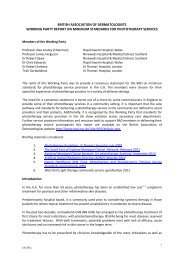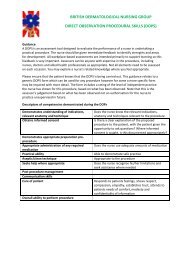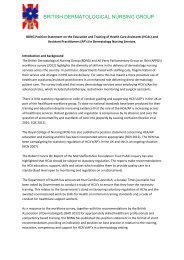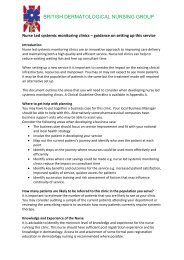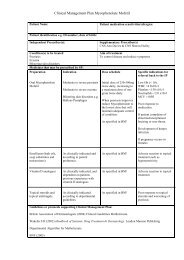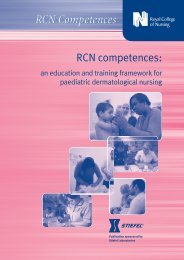Improving outcomes for people with skin tumours including melanoma
Improving outcomes for people with skin tumours including melanoma
Improving outcomes for people with skin tumours including melanoma
You also want an ePaper? Increase the reach of your titles
YUMPU automatically turns print PDFs into web optimized ePapers that Google loves.
Follow-up <strong>for</strong> patients after treatment <strong>for</strong> <strong>skin</strong> cancer should be<br />
tailored, as much as possible, to the individual, taking into account the<br />
patient’s needs and wishes. Options and decisions regarding follow-up<br />
should be made jointly <strong>with</strong> the patient.<br />
<strong>Improving</strong> Outcomes <strong>for</strong><br />
People <strong>with</strong> Skin Tumours<br />
<strong>including</strong> Melanoma<br />
Follow-up<br />
All patients should be given both oral and written in<strong>for</strong>mation about<br />
the different types of <strong>skin</strong> cancer and instruction about selfsurveillance.<br />
All patients should be given written instruction on how to obtain<br />
quick and easy access back to see a member of the LSMDT/SSMDT<br />
when necessary. GPs should be given advice about local arrangements<br />
<strong>for</strong> patients to re-access <strong>skin</strong> cancer services.<br />
Follow-up arrangements may include a combination of selfsurveillance,<br />
GP or other community doctor, and specialist nurse or<br />
hospital specialist clinic.<br />
Some patients, such as those who are immunocompromised or who<br />
have a genetic predisposition to the development of <strong>skin</strong> cancers (e.g.<br />
Gorlin’s syndrome, xeroderma pigmentosum), may need lifelong<br />
surveillance (see chapter on ‘Management of special groups’).<br />
Positron emission tomography (PET) scanning is not routinely<br />
recommended <strong>for</strong> follow-up; however, it may be useful <strong>for</strong> a small<br />
number of patients <strong>with</strong> suspected recurrent disease when clinical<br />
doubt remains after other <strong>for</strong>ms of imaging. PET scanning should<br />
there<strong>for</strong>e be available on a supraregional basis <strong>for</strong> these patients.<br />
5<br />
Basal cell carcinoma and squamous cell carcinoma<br />
Patients <strong>with</strong> BCCs or SCCs, <strong>with</strong> a low risk of recurrence, do not<br />
need long-term surveillance and should be discharged from <strong>for</strong>mal<br />
follow-up, but should be given in<strong>for</strong>mation and instruction as<br />
recommended above.<br />
Patients who are at high risk of recurrent or metachronous cancer or<br />
who find self-examination difficult require <strong>for</strong>mal follow-up. The<br />
period of time and frequency will depend on the degree of risk,<br />
which should be discussed <strong>with</strong> the patient. This may be particularly<br />
important <strong>for</strong> patients <strong>with</strong> high-risk SCCs, because of the more<br />
serious implications of locoregional recurrence.<br />
Guidance on cancer services: <strong>skin</strong> <strong>tumours</strong> <strong>including</strong> <strong>melanoma</strong><br />
105




